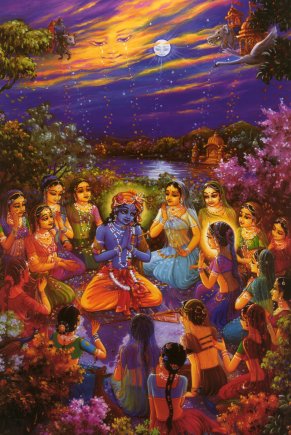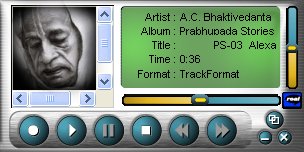|
|
|||
|
This
breeze comes from an ancient time, when the world was not polluted, when
the water and air were pure. The sweet scent it bears is of a great
culture, steeped in wisdom and philosophy, with dance and music both
powerful and uplifting, transporting us to a place of true delight.
It’s time to refresh the soul and focus on the joys of a pure and
simple life, to laugh and celebrate RasLila. Krsna
surya sama, maya hoy andhakar Krsna is like the sun and maya (illusion) is like darkness. Where the Krsna sun is present, there can be no question of darkness; the power of illusion is dissipated. Arts
and culture, religion and philosophy are meant to elevate mankind to the
perfection of human life. In the arts, we find this eternal quest for
perfection, signifying the highest level of existence. The mystical attraction of Eastern thought and culture have mesmerized mankind since before the beginnings of recorded history, and India has always been seen as a source of this mystic tradition in the East. I meditate upon Lord Sri Krsna, the Absolute Truth, the primeval cause of all causes, of the creation, sustenance and destruction of the manifested universes. It is he who first imparted Vedic knowledge unto the heart of Brahmaji, the original living being. By him even the great sages and demigods are placed into illusion, and by him one is freed from illusion. Only because of him do the material universes appear factual, although they are unreal. The highest truth is reality distinguished from illusion for the welfare of all. Such truth uproots the threefold miseries. This is, therefore, the ultimate goal of human life. We
all like to be entertained; witness the fact that entertainers are some
of the highest paid professionals in the modern world. RasLila is the
penultimate in entertainment, reminding us of our eternal existence in
the iimperishable, transcendental world that is never subject to
creation or annihilation. Experience the ultimate in entertainment –
RasLila.
To
find all of these aspects of religious, philosophical tradition, art and
culture, packaged together, is like finding a parash-mani
(touchstone), the fabled philosopher’s stone that can turn base ore
into gold. A cultural presentation for the re-spiritualization of
society. An age-old method for maintaining the proper direction in one’s life was to go on pilgrimage to a holy place, thus infusing one’s life with spiritual energy. Entangled as we are in the complex/cities of modern-day living many of us aspire to break away, if only for a short while, to get a breath of fresh air, a glimpse of something beyond the mundane humdrum of material existence. It
is said that as we take one step towards Sri Krsna, he takes ten towards
us. Now is our golden opportunity to go on pilgrimage to Sri
VrindabanDham, the eternal abode of Bhagavan Sri Krsna, by inviting Sri
VrindabanDham to come to us, through the medium of RasLila. RASA
LILA RasLila
is a folk tradition that has incorporated elements of Indian classical
music, drama and dance. This folk art is indigenous to Vraja, a tract of
land located today in Uttar Pradesh, India, between NewDelhi and Agra.
Vraja is associated since time immemorial with the pastimes of SriSri
RadhaKrsna, the DivineCouple, who harmonize the essential elements of
cultural and religious traditions inter-linked together throughout
antiquity. Swami FatehKrsna Sharma has especially excelled in synthesizing these two traditions to present an end product that is refined and sophisticated, yet not without the spontaneity of real life, as we still find people living in the villages of Vraja. Here we have simple villagers depicting the heights of aesthetic appreciation - a unique composition. This presentation goes beyond professionalism. Though the dramas have basic scripts there is ample room for improvisation and extemporization, just as an instrumentalist adds an alap, temporarily improvising on the raga, only to return to its formal delineation after the inspiration of the creative force is consumed. The emphasis is on 'seeing through sound' (darshan). The visual sense is to enhance, but the ultimate ingredient is the 'bhava', a particular mood or sentiment conveyed by the music and songs, which along with the action of the drama enable the actors and the audience to personally taste the different rasas, or dramatic flavours, such as friendship, servitorship, parental love, conjugal love, amazement, humour, chivalry, compassion, fury, fear and dread. |
When these sentiments are touched in connection with divine
reality, sometimes mistakenly thought to be imaginative mythology, the
result is an elevation in consciousness. Sterility and artificiality are
conspicuous here by their absence. Neither is so-called, civilized
behaviour a necessary constituent of Vraja society and culture, though
again we must be reminded that the aim here is to depict the
quintessence of reality. Rasa is a difficult word to translate into English in this instance, though the dictionary gives us some idea: juice, taste, savour, flavour, sentiment, subject, emotion, interest, humour, liquid, lymph, solution, secretion, moisture, love, lust, grace, beauty, joy, bliss, purport, pride, quicksilver, mercury. There
are actually two words included in 'rasa'. Rasa
that rhymes with 'bus', with a short first vowel, is the word defined
above. In it’s other manifestation, the first 'a' is long, and so
sounds similar to the pronunciation of ‘pass’. So, Rasa-lila
specifically indicates a circular dance of the gopis with Krsna, and as
well, playful pastimes in which the participants partake of different
flavours and thus savour the tastes of amorous dalliance in the company
of Sri Krsna. The members of the Rasa-lila troupe hail from various villages within Vraja. The principal members are young boys born in brahmana families throughout Vraja. They learn to read and write from the age of five or six but never attend public schools. In order to preserve the tradition, moreover, to keep the presentation free from contamination and impurity, since the subject matter is already abstruse by its very nature, these boys are sheltered from the influences of the modern world we live in, and are traditionally retired at puberty. In the case of some exceptional souls, performance on the stage might last up to the age of twenty-years. This pertains specifically to the roles of Sri Sri Radha Krsna and their confidantes, the girlfriends (sakhis; gopis) of Radha and Krsna. Peripheral roles, such as the mother of Radha or Krsna, may be accepted by young men disguised as ladies. The repertoire of the group is quite vast. They perform lilas that portray Krsna's pauganda, kaumara, and kaishor pastimes (the different stages of his youth). Radha and Krsna are always accompanied by four to eight sakhis. There are also musicians who accompany the rasadhari and a number of additional artists who accept the parts of the cowherd boys, Mother Yashoda, Nanda Baba, Vrishabhanu Maharaja, etc. In addition to Krsna Lila, they also perform Gauranga Lila, Ram Lila, and other pastimes of great devotees (Prahlada, Dhruva carita, etc.) Paternal roles give even the grandfathers of the young boys a chance to participate. Females are excluded from direct participation on the stage. There
are some families that have been immersed in the tradition for
generations. In the case of Rasacharya FatehKrsna Swami, who is a rasadhari,
he accepted the role of Thakurji, the swarup of Sri Krsna, in his youth,
and has now gone on to found his own troupe. A rasadhari
is the chief musician and singer whose task it is to present the rasa.
Swami FatehKrsna is an accomplished musician, expert at developing the
themes of the performances through the singing of various padas,
or songs, relevant to the particular lilas. A traditional performance generally lasts for about three hours. The first hour or hour-and-a-half consists of song and dance. Following this, Sri Krsna may sometimes give a short soliloquy, based on philosophy from the BhagavadGita and SrimadBhagavatam. The second half of the performance is an enactment of one of SriSri RadhaKrsna's unlimited pastimes, a delineation of spiritual rasa, or divine relationships based on pure love. Our
professed interests in religion, culture and morality are meant to help
us to hold up the fabric of civilization from trailing into the ditch.
Yet here is a religion and culture which starts with our genuine and
basic interest in life, the erotic attraction between male and female,
and strives to elevate that interest to a divine realm where
selflessness rules, rather than selfish desire. Sri Fateh Krsna Swami has performed in Europe in 1983 and 1986. In India he was presented the SangeetNatak Akademi award by Dr. Sankar Dayal Sharma, the President of India, for the outstanding excellence of his RasLila performances.
|
||
|
Home
|
Newsletter
|
Harmonium Lessons
|
Hot News
|
Real Audio Page
Copyright © 2005-2007 Hare Krishna Centre for Vedic Studies (Leicester) Hare Krishna Hare Krishna Krishna Krishna Hare Hare ::: Hare Rama Hara Rama Rama Rama Hare Hare |
|||


